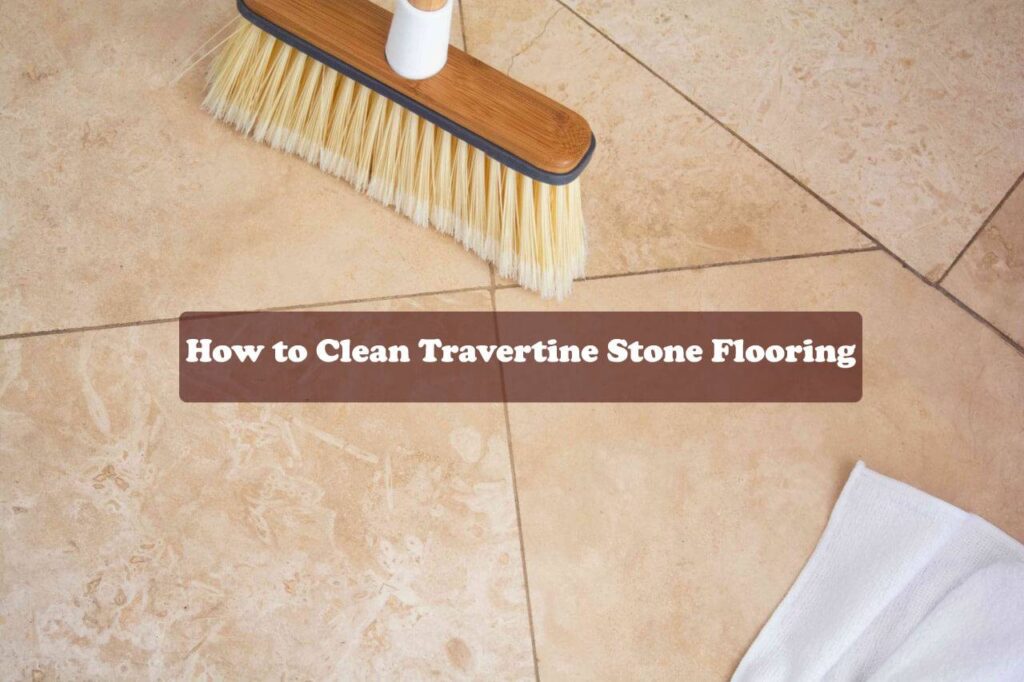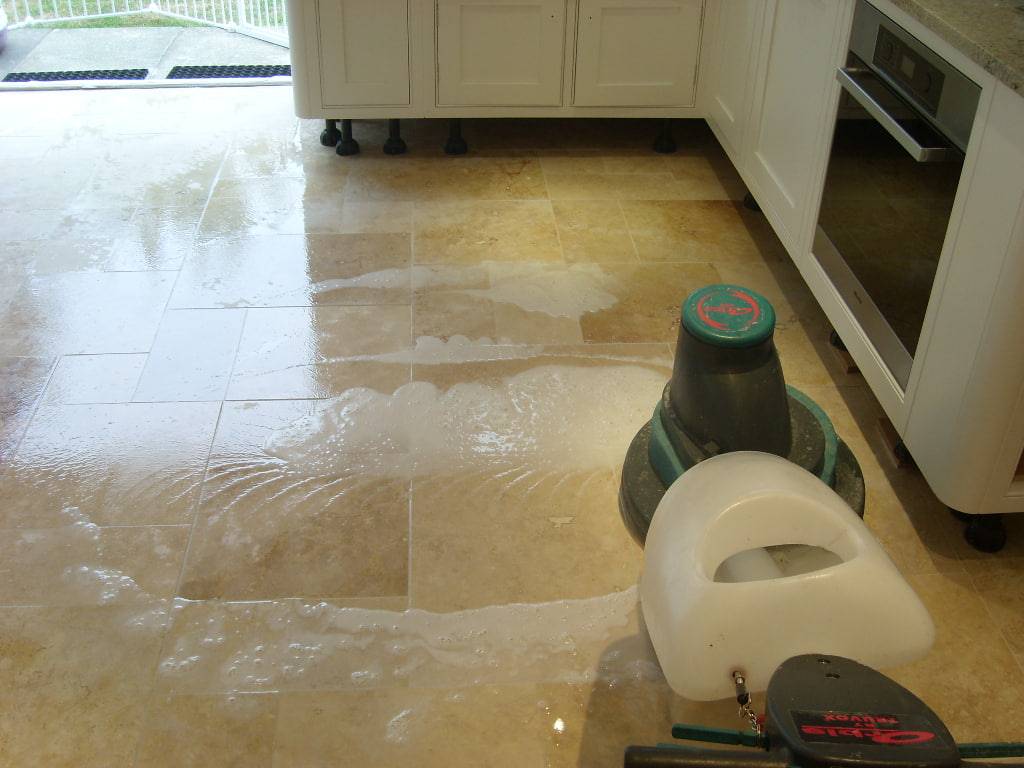Forget dull, dirty floors! Dive into the world of radiant travertine with this expert guide. From ancient quarries to modern homes, this stunning stone has graced buildings for millennia. But don’t let its durability fool you—its porous nature demands special care.
Here, we unveil the secrets to both everyday maintenance and deep cleaning, ensuring your travertine shines like new. Discover the best cleaners, explore natural acid-free options like baking soda, and learn foolproof techniques to tackle any mess. Follow these specific instructions and embrace the timeless beauty of your travertine masterpiece.
Keeping Your Travertine Thriving: Cleaning Frequency
Regular care is key to maintaining the beauty and longevity of your travertine floors. Here’s a breakdown of how often to tackle different cleaning tasks:
Weekly Maintenance:
- Sweep it up: Grab your broom or vacuum cleaner to remove dust and debris that can scratch the surface. Think of it as protecting the shine and preventing long-term wear.
- Mop it down: Weekly mopping with mild dish soap and warm water keeps dirt at bay. Skip the harsh chemicals – travertine prefers gentle care.
Pro Tip: Steam mops are great allies, using minimal water to avoid staining.
Monthly Boost:
- Disinfect like a pro: Include a disinfectant in your monthly cleaning routine to keep your floors germ-free.
Grout TLC (Every few months):
- Get down and scrub: Focus on those grout lines with a small brush and a non-acidic cleaning solution. Remember, clean grout means a happier floor!
Sealing for the Future (Every 3-5 years):
- Renew the shield: Replenish the protective sealant every few years to prevent stains and keep your travertine looking its best. Harsh chemicals and heavy use might require more frequent applications.
Bonus Tip: Don’t forget your cleaning tools! Regularly wash and dry your mop, bucket, and towels to avoid spreading dirt and grime.
Now, here’s what you need to tackle these tasks:
Cleaning Materials:
- Broom or vacuum cleaner
- Mop or sponge
- Mop bucket
- Towels
- Small, narrow scrub brush for grout
- 1 tablespoon mild, non-acidic dish soap
- Baking soda (optional)
- Warm water
- Stone cleaner (optional)
With this guide and your trusty cleaning crew, your travertine floors will shine for years to come!
Travertine Transformation: A Step-by-Step Guide
Ready to revitalize your travertine floors? Follow these simple steps, and voila! Sparkling beauty awaits:
- Banish the Dust Bunnies:
- Grab your broom or vacuum cleaner and give the floor a thorough sweep. Remember, those tiny dirt particles act like sandpaper, dulling your travertine’s shine over time.
- Embrace Gentle Hydration:
- Fill a bucket with warm water. Don’t drown your floors – wring out your mop or sponge so it’s barely damp. Saturating travertine can damage the sealant and lead to discoloration or mold growth.
- Disinfect with Dish Soap Power (Optional):
- Time for a monthly disinfecting boost? Mix a tablespoon of mild, non-acidic dish soap into a gallon of water. Mop with this solution, followed by clean water to remove residue. Don’t forget to towel dry!
- Grout Rescue Mission:
- Cleaning grout can be tricky – you need to be gentle on the travertine but effective on the grime. Mix equal parts baking soda and water to create a paste, then scrub gently with a small brush (avoiding the tile edges!). Alternatively, use a stone cleaner specifically designed for travertine.
Bonus Tip: Give your cleaning tools some TLC too! Regularly wash and dry your mop, bucket, and towels to prevent spreading dirt.
Taming the Pores: Sealing Your Travertine for Lasting Beauty
Natural travertine’s rustic charm comes with a catch – microscopic pores that act like sponges for liquids, leading to stains, discoloration, and even mold. But fear not! Sealing your travertine is the key to unlocking its true potential.
Two Sealing Titans:
- Deep Penetrator: This warrior seeps deep, clogging pores and creating a moisture barrier within the stone.
- Surface Barrier: This hero forms a clear shield on top, deflecting spills and preventing stains.
The Sealing Dance:
- Initial Seal: Apply the deep penetrator after installation.
- Top it Off: Add the surface barrier for extra protection.
- Repeat: Reapply the surface barrier every few years to maintain the magic.
Color Chameleon:
Sealers can deepen travertine’s natural hues and add a subtle shine. Want that classic weathered look? Use the surface barrier less frequently. Embrace the choice – your travertine, your style!
Remember:
- Choose sealants specifically designed for travertine.
- Test in an inconspicuous area first.
- Follow the manufacturer’s instructions carefully.
Travertine: Keeping Your Stone Sparkling with Simple Steps
Travertine’s beauty deserves to shine! Here’s how to maintain its luster and prevent costly repairs:
Cleanliness is Key:
- Embrace mildness: Ditch harsh chemicals! They can stain your travertine’s naturally alkaline surface. Opt for gentle, pH-neutral cleaners.
- Grout patrol: These vulnerable spots are stain magnets. Don’t use bleach-based cleaners from ceramic tile – they’ll etch your travertine. For deep cleaning, consider professional help.
- Regular rescue: Daily dry mopping and prompt spill blotting prevent dirt and stains from settling in.
Sealing for Success:
- Seal it up: Protect your travertine with a porous sealer. This invisible shield repels spills and stains, saving you headaches.
Dos and Don’ts:
- Do: Seal regularly, blot spills, and sweep daily.
- Don’t: Use acidic cleaners, vacuum (scratches!), or attempt DIY deep cleaning.
Bonus Tip: Regrouting can revitalize your floor! Consider it as a more affordable alternative to complete replacement.
Frequently Asked Questions about Travertine Floors:
How often should I clean my travertine floors?
- You should sweep or dry mop daily to remove loose dirt and debris.
- Weekly mopping with mild dish soap and warm water is recommended.
- Disinfect monthly with a non-acidic solution.
- Deep clean grout every few months using a gentle scrub brush and appropriate cleaner.
What kind of cleaner should I use on travertine?
- Avoid harsh chemicals and acidic cleaners, as they can damage the stone.
- Use mild, pH-neutral dish soap or stone cleaners specifically designed for travertine.
Can I vacuum my travertine floors?
- It’s not recommended, as vacuuming can scratch the surface.
- Opt for sweeping or dry mopping instead.
How do I remove stains from travertine?
- Blot up spills immediately to prevent them from setting in.
- For tougher stains, consult a professional cleaning service.
Do I need to seal my travertine floors?
- Yes, sealing is essential to protect your travertine from stains, discoloration, and mold growth.
How often should I seal my travertine floors?
- Reapply the sealant every 3-5 years, or more often in high-traffic areas.
What type of sealer should I use?
- Choose a penetrating sealer and a surface sealer specifically designed for travertine.
- Always test the sealer in an inconspicuous area first.
What are some common mistakes people make when cleaning travertine?
- Using harsh chemicals, acidic cleaners, or bleach.
- Saturating the floor with water.
- Vacuuming the floor.
- Attempting DIY deep cleaning without proper knowledge.
How can I keep my travertine floors looking their best?
- Regular cleaning and maintenance is key.
- Promptly address spills and stains.
- Reseal the floor regularly.
- Use doormats to prevent dirt and debris from tracking in.


